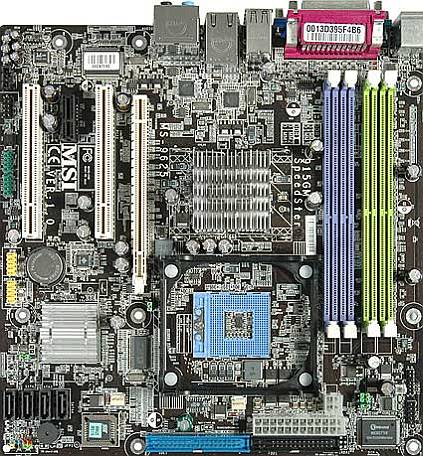Dual Core Processors For Low-Power, High-Performance Desktops
... And MSI 915GM Speedster
If you shop for Socket 479 motherboard you will likely find several products, but some are more suitable than others for building a low-power PC. Intel's 915G chipset is the desktop version with integrated graphics, while the 915GM was designed for notebooks. For this reason, it is not surprising that while the 915GM is much more efficient, it is more expensive - and thus not widely used. In contrast to the desktop chipsets, the mobile version supports a maximum memory total of 2 GB.
MSI sent us its 915GM Speedster, which is based on the mobile version 915GM. The box includes a suitable Pentium M processor cooler and the usual utilities. Both chipset building blocks are equipped with heat sinks, which is enough to keep them within acceptable temperature boundaries.
The integrated Intel GMA900 graphics engine is not very impressive, because it is too slow to play any of the current 3D titles at a decent resolution. But the motherboard has a x16 PCI Express slot that can be used to install a discrete graphics card to replace the integrated graphics core. Doing this will make the system perform far better, but will also increase its energy requirements.
We used an ATI Radeon X800XL, which consumes at least 20 W of additional power; that figure must be added to the excellent consumption profile of 38 to 68 W. But the Pentium M solution remains the most efficient platform even when a discrete graphics solution is added. It would have been great to run Core Duo on this motherboard, but that requires the current specification update for Socket 479 as well as the 945G or 945GM chipset.
The Pentium M 780 is adequate for most office and multimedia application scenarios today, and even dominates the benchmarks for audio encoding and WinRAR file compression. The more you move into content creation or other types of professional applications, however, the sooner we recommend going for a dual core processor.
Get Tom's Hardware's best news and in-depth reviews, straight to your inbox.
Current page: ... And MSI 915GM Speedster
Prev Page The King Of Efficiency: The Intel Pentium M 780 Next Page MSI 915GM Speedster, Continued
Patrick Schmid was the editor-in-chief for Tom's Hardware from 2005 to 2006. He wrote numerous articles on a wide range of hardware topics, including storage, CPUs, and system builds.
